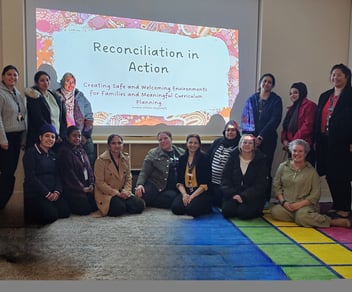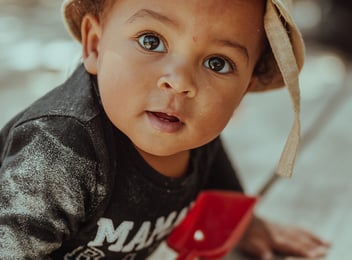Language development in young children begins long before their first words - it begins with gaze, gesture, tone and turn-taking. At ECMS, we understand that communication is woven through every moment of early childhood, especially in those critical first three years.
That’s why our approach to language learning for young children is grounded in relationship. Not flashcards or formal instruction, but the deep, attuned interactions that happen in nappy changes, mealtimes, and the quiet noticing of a child’s cues. We know from decades of research - and lived practice - that these early exchanges shape the foundations of language, identity and learning for life.
It starts with attunement
The ECMS Birth to Three project was designed to reimagine learning for young children from birth to three, through a lens of relational practice. At the heart of this work is Dr Katherine Bussey - researcher, educator, Pikler pedagogue and mentor. Her words speak directly to our practice:
“Respectful attuned relationships are not just desirable, they are key to the curriculum” (Bussey, 2024).
Attunement means slowing down. Noticing the small shifts in a child’s movement or mood. Waiting for their response. It’s a way of being, not doing - and it sets the stage for language to emerge.
When a young child picks up a spoon and looks to their educator, that’s an invitation. When the educator kneels down, names the object, mirrors the action and waits - that’s conversation.
Care is the curriculum
Grounded in the Pikler approach, ECMS educators view care routines as central to the learning experience. “Every nappy change, every meal, every hand held or eye met, these are powerful learning moments when they are approached with intentionality, respect and collaboration” (Bussey, 2024).
Rather than rushing through daily care tasks, our teams treat them as shared rituals - moments of connection rich with possibility. During a nappy change, a child hears their name, is invited to hear what will happen next, feels the consistency of voice and gaze. Over time, this builds the rhythm of language: sequencing, comprehension, trust.
This approach is deeply aligned with the Early Years Learning Framework, which places belonging, being and becoming at the centre of early development. EYLF V2.0 states:
“Language development is embedded within responsive, reciprocal relationships and rich communication environments” (Australian Government Department of Education, 2022).
It’s not about teaching young children to talk. It’s about making space for them to be heard.
Language lives in relationship
In the ECMS Birth to Three project, Practice Coach Gracie Pupillo works with teaching teams to create these spaces - not through checklists, but through reflection, coaching and courageous conversations. This includes rethinking routines, slowing transitions, and offering children more agency in their day.
At Oakhill Family Centre, these shifts were subtle but transformative: young children were given more choice at mealtimes, sleep was no longer strictly scheduled, and toileting became a co-regulated learning moment. All of it infused with gentle language and open-ended dialogue.
The result? A more confident team, more responsive practice - and children more deeply engaged in their world.
Dr Bussey reminds us:
“Care routines offer repeated opportunities for language, bodily awareness, and the foundations of learning - or, if rushed, they can imprint disengagement that lasts far beyond the moment” (Bussey, 2024).
We’re still learning too
This work is ongoing. Language learning isn’t a checklist of milestones - it’s a story of relationship, culture, curiosity, and place. At ECMS, we honour the child as a capable communicator from birth, and the educator as a co-learner who listens deeply.
By investing in the first three years as a pedagogical priority - we’re advocating for what matters. For children to be seen, heard and known. For teaching teams to be supported, respected and trusted. And for learning to be grounded in the magic of everyday moments.
Because before children communicate, they find connection. And that’s where language truly begins.
References:
- Bussey, K. (2024). Presentation at the Infants and Toddlers: Practice, Pedagogy and Research Conference, Macquarie University.
- Australian Government Department of Education. (2022). Belonging, Being & Becoming: The Early Years Learning Framework for Australia – V2.0.
- Pikler, E. (1979). Peaceful Babies, Contented Mothers. Budapest: Pikler Institute.
- ECMS. (2024). Attuned and Responsive Practice: ECMS Birth to Three Project.



